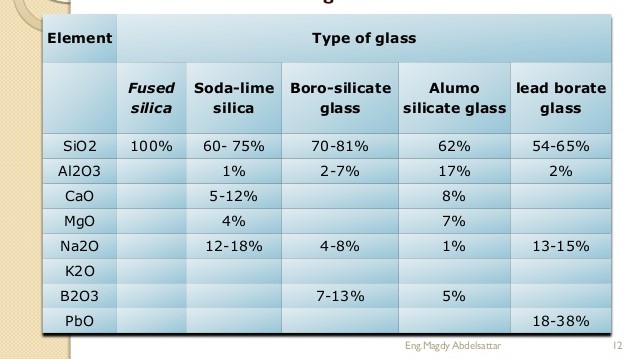Glass is a non-crystalline amorphous Super Cooled Liquid that is often transparent and has widespread practical, technological, and decorative usage in, for example, window panes, tableware, and optoelectronics.
Firstly the glass was manufactured in Egypt. Ordinary glass is manufactured by the composition of various substances like silica, bleaching powder, oxides of alkaline metals, calcium oxide (lime) etc. Basically glass is the homogenous mixture of the silicates of various alkaline metals of non-crystalline and transparent or less transparent substances.
Types of Glass
Water glass: It is manufactured from the compound of sodium silicate (Na2Si03) by heating sodium carbonate and silica. It is soluble in water.
Photo chromatic glass: This is a special type of glass which turns black in sharp shining light thus such glasses are used as light protector and eyes reliever and thereby utilised in making eye lenses and goggles. The main reason of being black of such glasses is the presence of silver iodide.
Pyrex glass: It is also called borosilicate glass. It has some specific characteristics of chemical durability and more thermal inmalleable resistance power.
Lead crystal glass: This is a special type of glass which is used in making various ornamental items by the appropriate decorative, cutting and designing. Infact on cutting such glasses the optical phenomenon of total internal reflection takes place very sharply and thus a pleasureous dazzling light is produced.
Soda glass: It is also called soft glass which is brittle and the cheapest and most commonly existing glasses. This can be broken very conveniently and by the alternation of temperature some cracks appear in such glasses.
Xena Glass: It is the best form of glass and from it chemical containers and equipments for the scientific purposes are manufactured. This glass is basically composed from zinc and barium borosilicate which produces the soft and good quality of glass.
Flint Glass: It is manufactured from sodium, potassium and lead silicates which are used in making idol objects of cultural importance, costly glass equipments or devices. Such glasses are also used in making electric bulbs, lenses of telescopes, microscopes, camera and prisms, etc.
Crown glass: Usually this is a soda-lime-silica glass and it is frequently used in making lenses of eye glasses.
Crookes glass: In this glass mainly cerium oxide (CiO2) is present which sharply absorbs the ultraviolet rays from the sunlight so utilised in making lenses of eye glasses.
Quartz glass: This is also called silica glass because it is obtained by melting silica and ultraviolet rays emerge out through it. Thus it is used in making bulb of ultraviolet lamp, in making container of chemical reagents, laboratories equipments etc.

